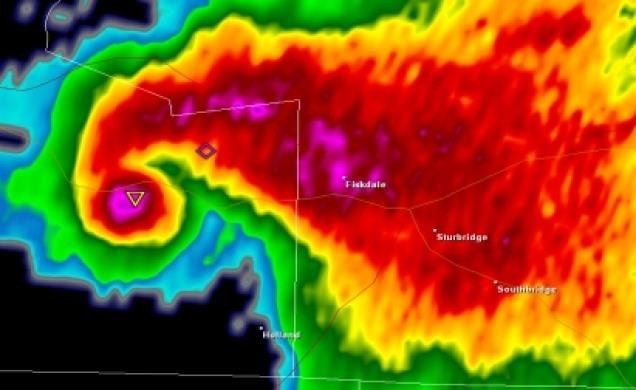-
Posts
78,776 -
Joined
-
Last visited
Content Type
Profiles
Blogs
Forums
American Weather
Media Demo
Store
Gallery
Everything posted by weatherwiz
-

Feb 28th-March 1st long duration Miller B threat
weatherwiz replied to George001's topic in New England
Well this is encouraging to see. Small window of getting some intense lifting into the DGZ which will be huge given how high it is. You can also see the snow ratio jump during this window as well. This would be a solid 1-2'' per hour rates verbatim. This is BDL -

Feb 28th-March 1st long duration Miller B threat
weatherwiz replied to George001's topic in New England
It may in the sense that the overall profile is colder with latitude. But here is 700mb temps for 9z Tuesday which is within the window of the heavier rates. We certainly can get great snow growth with intense llvl lift and llvl cold but I'm not sure it's cold enough to offset this "warmth" and very high DGZ. I think we would really struggle to generate good dendrites. I could see very tiny flakes which even resemble sleet. -

Feb 28th-March 1st long duration Miller B threat
weatherwiz replied to George001's topic in New England
It seems pretty close. 925/850 are certainly cold enough for snow but the surface could be a question. I guess we'll have to see how much temperatures climb through the day Monday. With thick cloud cover coming in quickly we may not drop much during the evening and until we get a more northeasterly component to the wind. Above 925/850 though seems to raise some big questions. Verbatim the GFS is only around -2C to -3C at 700 and -17C to -19C. With the majority of the lift well below this I can see horrific snow growth (even a solid mixture of sleet). Will wait for 12z GFS bufkit, but my guess is we would be looking at snow ratios around 7:1 or so. -

Feb 28th-March 1st long duration Miller B threat
weatherwiz replied to George001's topic in New England
ughh I was pretty excited with some features of the GFS looking better...but I seriously think we would struggle to really accumulate. -

Feb 28th-March 1st long duration Miller B threat
weatherwiz replied to George001's topic in New England
Also something to keep in mind is, looking through some soundings really quickly, it seems like the DGZ is going to be relatively high, well above the greatest lift. This would have a substantial impact on snow growth and ratios. -

Feb 28th-March 1st long duration Miller B threat
weatherwiz replied to George001's topic in New England
It appears as if it takes a bit longer for the shortwave to totally get sheared apart on this run. But this is some beast WAA -

Feb 28th-March 1st long duration Miller B threat
weatherwiz replied to George001's topic in New England
HOly shit...I just saw a good sized limb break off the pine tree and come down -

Feb 28th-March 1st long duration Miller B threat
weatherwiz replied to George001's topic in New England
This is going to be the most intriguing aspect in terms of forecasting potential snowfall totals. There is going to be an extremely tight temperature gradient within a short-distance. If that does verify, there is going to be a very narrow intense banding of enhanced fronto in the 850-700 layer. Where that occurs and if it does is where the strip of highest totals will be. One thing to watch too is east slopes of the Berks who could destroy in this (as usual) -

Feb 28th-March 1st long duration Miller B threat
weatherwiz replied to George001's topic in New England
Getting super excited now, just scared of being let down. I'll even take 3-4''. In this winter that would make me happy. -
I would like to winter of winter in two ways 1) Seasonal snowfall accumulation. 2) How many accumulating snowfall events (with a subset of events greater than specific amounts). But then it's also really too each their own. Someone who got say 50'' (which is about their average) but 35'' came from two storms may call it a solid winter while someone who got 50'' (about their average) but it was spread out between about 7-8 storms is a solid winter.
-
Anyone else noticing birds acting crazy? Crows are going wild...a giant swarm of them and they all screaming.
-

Feb 28th-March 1st long duration Miller B threat
weatherwiz replied to George001's topic in New England
My timeline must be way off. This is why recollection from memory alone can be a terrible idea. -

Feb 28th-March 1st long duration Miller B threat
weatherwiz replied to George001's topic in New England
Ahhh yes, that's the one I was thinking of. -

Feb 28th-March 1st long duration Miller B threat
weatherwiz replied to George001's topic in New England
I swear we had one sometime in January. I remember being super excited and once it went to crap I virtually just checked out. -

Feb 28th-March 1st long duration Miller B threat
weatherwiz replied to George001's topic in New England
My memory doesn't work the same anymore, so I can't remember specific dates but there were a few. -

Feb 28th-March 1st long duration Miller B threat
weatherwiz replied to George001's topic in New England
I may be wrong, but I think the 18-24'' was to account for both rounds as they were getting two rounds of heavy snow. One was Monday night into Tuesday and the second Tuesday night into this morning. -

Feb 28th-March 1st long duration Miller B threat
weatherwiz replied to George001's topic in New England
We've had multiple. Perhaps the more noteworthy one was maybe a month or so ago. The agreement was through the roof. There was even one earlier in the winter. -

Feb 28th-March 1st long duration Miller B threat
weatherwiz replied to George001's topic in New England
eh it's not a game of predicting what a model will do. Remember, models are essentially just tools, forecasting goes well beyond just taking model output verbatim, as you know. But even looking at the 12z GFS...it's a great piece of voriticty that ejects through the Ohio Valley and then just gets shredded and becomes a vorticy mess. Once the occlusion happens, the WAA turns to a halt, and sure while there is vorticity and forcing still traversing the region, to me, it just seems like we'd be dealing with a broken precipitation shield with crappy precipitation rates. Just think about how many potential events have looked good over the past 2-3 winters and once we got inside the day 3-4 mark have just gone to crap. We would all be excited because of strong model agreement, whether it be OP and ensembles or good ensemble support, then we get to that D3-4 mark...one model comes in like crap, and we just b/c maybe it was the NAM or an "off-hour 18z GFS" and then all of a sudden, slowly there is that trend. This has happened way too many times to just be a coincidence over and over...there's obviously a reason for that (what that reason is makes for great debate). -

Feb 28th-March 1st long duration Miller B threat
weatherwiz replied to George001's topic in New England
I'm not totally dismissing that, but we've seen how terrible the models performances have been this winter and the past 2-3 winters. I get the "taken at face value" concept, but what does that really do? The way I see this, looking at the synoptic setup is, we are going to have to rely heavily on the WAA induced precipitation for some widespread heavy snow. This is something that certainly isn't impossible, but we have seen countless times, where even ensembles are in strong agreement, only for things to "crap" the bed as we get closer...it's a theme that has been repeated countless times these past few years. How I am envisioning this playing out, based on the synoptics is, if this look were to remain constant through the weekend we would see a trend towards a weaker event and not a stronger one. My reasoning for that is within my earlier post. The flow is very fast and we've seen many times this winters that shortwaves open up, become flat, and occlude as they accelerate northeast through the Plains into the upper-Midwest/Ohio Valley region. The result is a rapidly occluding parent low. It's just so difficult to take anything at face value now because the models have struggled mightily, even with the synoptic evolution and even within the short term. -

Feb 28th-March 1st long duration Miller B threat
weatherwiz replied to George001's topic in New England
It was a pretty interesting setup when looking at the models the day before. I wasn't thinking tornado, but thought damaging wind gusts/hail would be possible. Dynamics were quite strong with very steep lapse rates. Not totally true, but that did happen two winters ago. -

Feb 28th-March 1st long duration Miller B threat
weatherwiz replied to George001's topic in New England
ehhh I'm not that good with winter weather, but I try to look at it from an objective side and not let one or two products influence my thinking. -

Feb 28th-March 1st long duration Miller B threat
weatherwiz replied to George001's topic in New England
What I hate about this is the flow is so fast and as the shortwave flies across the country it opens up, flattens out, and the main low rapidly occludes. Of course the other issue is the models have been rather horrific lately with the evolution of the pattern into the medium range and the synoptic details so it's been increasingly difficult to take any merit looking a few days out. My initial thinking is the best best for heavy widespread precipitation will be with the front end with strong WAA and everything after that is just shredded crap. Relying on something like an IVT or hoping for the secondary to pop exactly where we want/need it is like trying to connect a hail mary from your own 30 with below-average arm strength. We've seen this modeled setup several times over the past few years. -

Feb 28th-March 1st long duration Miller B threat
weatherwiz replied to George001's topic in New England
It's a shame what some of these products do within the field. Model snowfall maps with winter weather and supercell composite/significant tornado parameter and that ridiculous AI CIPS or whatever it is. Even if these products have value (which they do) they're used so irresponsibly that every single "event" that pops up on guidance, whether it be some severe threat in the Plains or winter event in the Northeast gets totally blown out of proportion. -
Best looking storm we'll see all summer Was pretty intrigued yesterday for some strong thunderstorm potential today. Was shocked there wasn't even a general thunderstorm line yesterday afternoon.
-
I also sent an email to PSL with a user enhancement suggestion. It would be PHENOMENAL if multiple composites can be downloaded at once. The way I do it is I create a composite, copy it, and paste it into a pain document. So if I'm doing weak La Nina winter temperature anomalies, I'll put in each year (one at a time) to make the composite then put into paint. This process is TEDIOUS and extremely time consuming. In reality, I'd never accomplish what I'm trying to do. Would have to work 24/7 on it lol






